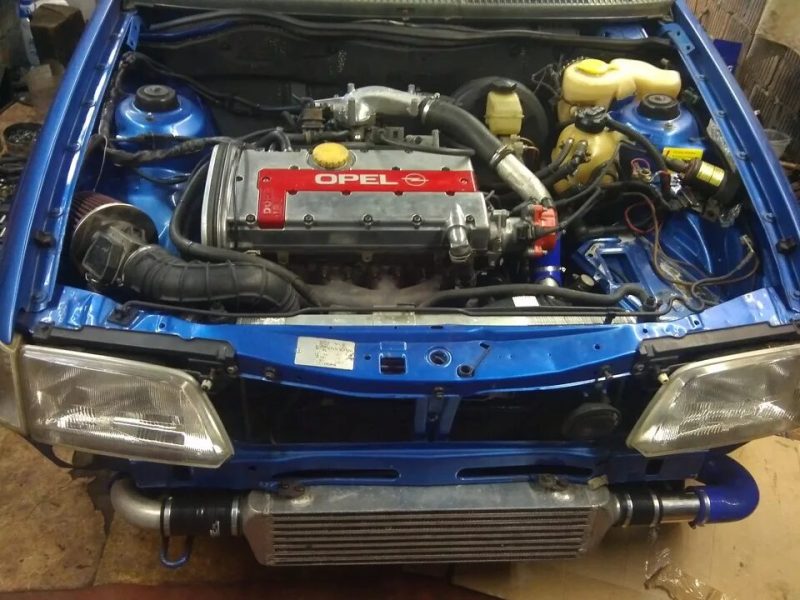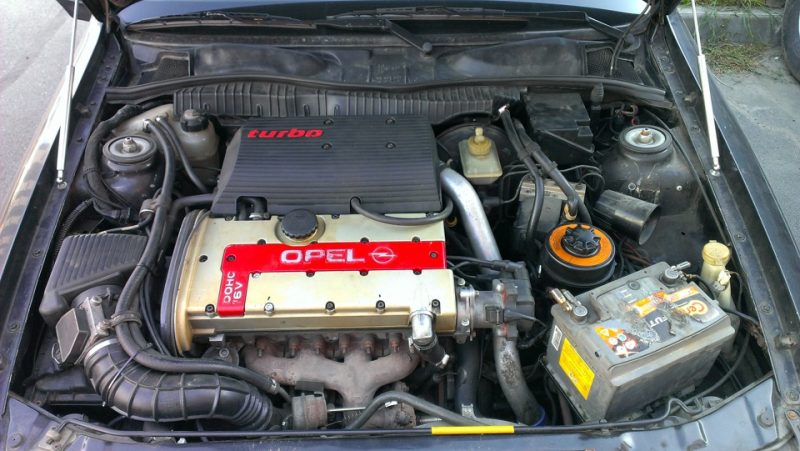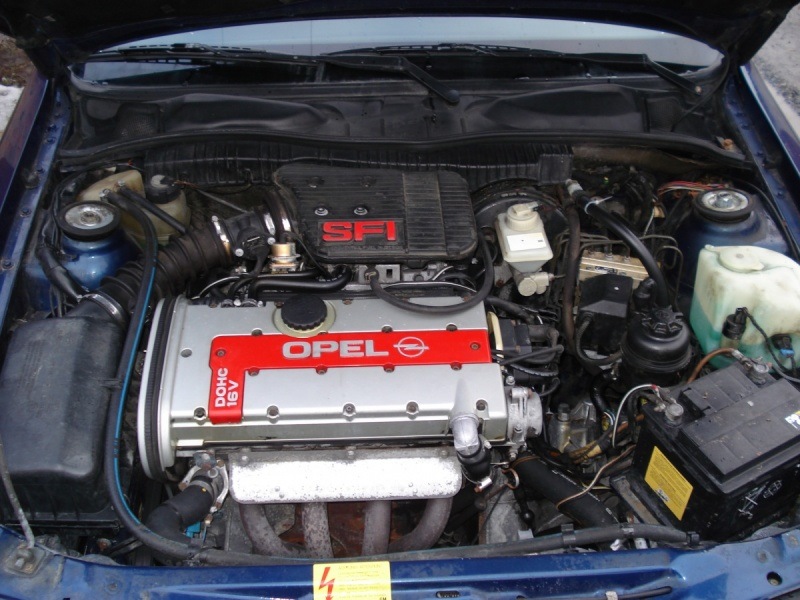Opel C20XE 2.0 engine specifications
| Parameter | Value |
|---|---|
| Exact volume | 1998 cm³ |
| Power system | Distributed injection |
| Power | 150 hp |
| Torque | 200 Nm |
| Cylinder block | Cast iron, R4 |
| Cylinder head | Aluminum, 16v |
| Cylinder diameter | 86 mm |
| Piston stroke | 86 mm |
| Compression ratio | 10.5 |
| Features | No |
| Hydrocompensators | Yes |
| Transmission timing | Belt drive |
| Fasoregulator | No |
| Turbocharger | No |
| What oil to use | 4.50 liters, 5W-30 |
| Ecological class | Euro 1 |
| Example service life | 300,000 km |
| Engine weight | 136 kg |
Opel C20LET 2.0 Turbo engine specifications

| Parameter | Value |
|---|---|
| Exact volume | 1998 cm³ |
| Power system | Distributed injection |
| Power | 204 hp |
| Torque | 280 Nm |
| Cylinder block | Cast iron, R4 |
| Cylinder head | Aluminum, 16v |
| Cylinder diameter | 86 mm |
| Piston stroke | 86 mm |
| Compression ratio | 9.0 |
| Features | No |
| Hydrocompensators | Yes |
| Transmission timing | Belt drive |
| Fasoregulator | No |
| Turbocharging | Yes |
| What oil to use | 4.50 liters, 5W-30 |
| Fuel type | AI-92 |
| Ecological class | Euro 1 |
| Example service life | 250,000 km |
| Engine weight | 145 kg |
Application of C20XE 2.0 16v engine
| Model | Generation (code) | Years of production |
|---|---|---|
| Opel Astra | F (T92) | 1991 – 1996 |
| Opel Calibra | A (C89) | 1989 – 1994 |
| Opel Kadett | E (T85) | 1988 – 1991 |
| Opel Vectra | A (J89) | 1988 – 1994 |
Application of C20LET 2.0 Turbo 16v engine

| Model | Generation (code) | Years of production |
|---|---|---|
| Opel Calibra | A (C89) | 1992 – 1997 |
| Opel Vectra | A (J89) | 1992 – 1994 |
Design and repair of Opel C20XE and C20LET engines
Two-liter 16-valve C20XE was released in 1988, as a replacement for the 20XE, from which it differed from the catalytic converter and lambda-probe, which allowed it to meet environmental standards Euro-1. The cylinder block on the C20XE was cast from cast iron and was 216.3 mm high, with an 86 mm stroke crankshaft, 143.1 mm connecting rods, and 86 mm diameter and 30.43 mm high pistons.
The block is covered by a 16-valve head mounted on a 1.4mm-thick gasket. Unlike the related C20NE, there are 4 valves per cylinder, the inlet valves are 33mm in diameter, the exhaust valves are 29mm, and the stem diameter is 7mm. Characteristics of C20XE camshafts: phase 252/252, lift 9.5/9.5 mm.
The timing drive on C20XE is belt-driven, timing belt replacement is necessary every 60 thousand kilometers. Without doing this, you risk getting a belt break, after which the motor will bend the valves.
This motor does not require adjustment of valves, as there are hydrocompensators.
The injector capacity on the C20XE is 214 cc.
In 1993, the motor was restyled and received a new ignition system without a tumbler, modified cylinder head and timing drive, a different exhaust camshaft, DMRV, 241 cc injectors, as well as a control unit Motronic 2.8 (prerestyling was Motronic 2.5).
Based on this atmospheric motor, a turbocharged C20LET was created, which differed from the C20XE with deeper puddle pistons, which lowered the compression ratio to 9. KKK-16 was used as a turbocharger, supercharging pressure in the stock 0.5 bar. Among the differences: 304 cc injectors, camshafts 251/250 with 8.5/8.5 mm lift, Bosch Motronic 2.7 control unit.
In 1996, the C20XE and C20LET engines were removed from production and instead of them began to put X20XEV.
Problems and disadvantages of Opel C20XE and C20LET engines
Cracks in the cylinder-head
A clear sign of a problem is oil in the expansion tank. The best option is to buy a Coscast head from Cosworth, which is devoid of this problem. But it is possible to repair your own head by bluing the channel, there are quite a few specialists who do this kind of work.

Otherwise, the motor has no obvious problems and diseases, everything works fine, but age spares no one and, with such serious mileage as you have now, C20HE can present you with any problem at any time.
Disadvantages, breakdowns and problems of the C20XE
- G timing belt.
The timing belt has a lifespan of around 50,000 kilometers, but in reality it can break sooner. This leads to bent valves and costly repairs. - Ignition system
On pre-1993 versions of the engine, there have been problems with the reliability of the ignition system, causing engine malfunctions. - Hydrocompensators.
These elements are sensitive to oil quality. The use of cheap oil leads to their wear and the appearance of a characteristic knock by 90,000 km.
Disadvantages, breakdowns and problems of C20LET
- Modifications and tuning
Most owners carry out engine modifications to increase power. Often problems are associated precisely with incorrect tuning and the complexity of tuning the mixture system. - G timing belt
The timing belt on this engine serves about 50-60 thousand kilometers. Breakage of the belt almost always leads to valve bending. - Thermostat and pump
Low life of the thermostat and pump is another common problem. These components require regular inspection. - Electronic sensors
Owners often complain of electronic sensors failing, including temperature, oxygen and turbine pressure sensors.
Opel C20XE and C20LET engine tuning
C20XE on the throttles
To get just over stock power, roughly 170+ hp, you’ll need to overhaul the motor and get it in perfect condition, then, put in throttles, replace the exhaust manifold with a 4-2-1 with a straight 63mm exhaust, and aggressively flash the ECU. By adding Schrick 276 camshafts, you can get under 200 hp. The stock motor is better not to spin above 7000-7200 rpm – the connecting rod bolts do not hold too high rpm (above 7500 rpm). So if you plan to install evil camshafts, it is better to put ARP bolts, oil pump from Z20LET, and then already forged pistons under compression ratio 11, light connecting rods, lightweight flywheel and balance everything, do head porting, buy valves (inlet 34, outlet 30 mm) with springs, pushrods, titanium plates, you will need bronze guides, injectors C20LET. For ease of tuning, you can transfer your C20XE to a January control unit. In the end, all of this combined will give well over 200 hp.
C20XE Turbo/C20LET
Stock C20LET motor with EDS Phase 1 chip gives 260 hp. With the EDS Phase 2 chip, with intercooler, new plugs, ARP connecting rod bolts and 470 cc injectors, it shows 280 hp at 1 bar boost, which is good enough for active driving. With the EDS Phase 3 chip and a 63mm pipe exhaust, at 1.15 bar boost pressure, you can get 300hp. With the EDS Phase 3.5 chip and at 1.25 bar boost, with a Walbro 255 pump, you can get some more power (~320 hp). Instead of EDS, you can convert your C20LET to January and customize everything yourself. To get 350+ hp you will need a turbo from Mitsubishi Evo TD05, with a normal manifold, with block-off, with reinforced H-beam connecting rods, ARP studs, more productive injectors (~700 cc), you will need a large intercooler, intake shaft C20XE, oil pump Z20LET, control unit January.
MOTOR RATING: 4+
